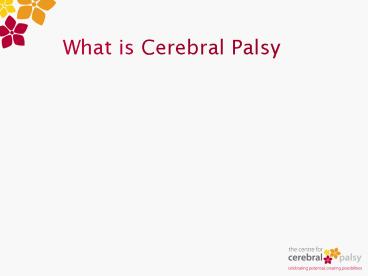What is Cerebral Palsy - PowerPoint PPT Presentation
1 / 13
Title: What is Cerebral Palsy
1
What is Cerebral Palsy
2
What is Cerebral Palsy
- Cerebral Brain
- Palsy weakness, paralysis or lack of muscle
control.Cerebral Palsy (CP) is a permanent
physical condition that affects movement. Its
effect can be as mild as just a weakness in one
hand ranging to almost complete lack of movement.
3
Causes of Cerebral Palsy
- Cerebral Palsy can occur before, during or
after birth (up to 5years of age) while the brain
is developing. - It can be caused by
- Trauma (accidents, near drowning)
- Infection (German Measles while pregnant or
encephalitis when young) - Problems with pregnancy (lack of oxygen,
premature, low birth weight) - However in 40 of cases the cause is unknown.
4
Types of Cerebral Palsy
- Cerebral Palsy is classified by three things
- The type of movement or muscle tone
- The body part or parts effected
- The degree of severity
5
Types of Movement or Muscle Tone
- Spastic Cerebral Palsy This is the most
common about 80 of people have this type. The
muscles are tight and movement is stiff and
awkward - Dyskinetic Cerebral Palsy Least common,
about 10. - Athetosis The person has uncontrolled, writhing,
floppy movements and - Dystonia The person has intermittent,
alternating muscle contractions resulting in
twisting or repetative movements. - Ataxia Movements are shaky (tremor) and there
are problems with balance and coordination - Mixed A combination of 2 or more of the
above
6
The body part affected
- Hemiplegia
- Difficulty moving and using one side of the body.
The arm is often more affected than the leg. The
affected side can be smaller due to tight muscles
and a lack of growth. - Neglect of affected side, resulting in lack of
use. - Problems reaching and grasping with affected
hand. - Lack of feeling on the affected side of the body.
- The person usually has a bent arm (flexed) and
the hand is fisted. The leg is stiffened and they
walk on tiptoes.
7
The body part affected
- Diplegia
- Difficulty moving the lowerpart of the body due
to stiffness of the legs - Difficulty straightening fully at the hips
- Difficulty with balance when standingor walking
- The person often has a tilted head and shoulders
back in an attempt to achieve an upright
position, creating an exaggerated curve in the
lower back. When walking they move the trunk
excessively to compensate for stiffness of the
legs.
8
The body part affected
- Quadriplegia
- All four limbs affected
- Trunk, neck and head often affected
- The person often has problems controlling the
mouth and tongue muscles. - Individuals generally are unable to walk and
either are unable, or have extreme difficulty in
fine motor tasks. - Can develop scoliosis (curvature of the spine),
hip dislocation, bladder and bowel problems.
9
The severity
- Cerebral Palsy can be classified by how severe
its effects on movement and muscle tone are
- Severe
- Moderate
- Mild
- All three areas (movement, body part and
severity) are then joined together to classify or
describe the type of Cerebral Palsy eg Severe
spastic hemiplegia.
10
Effects of Cerebral Palsy
- Cerebral Palsy can effect
- Mobility and balance
- Posture and growth
- Communication language
- Fine motor control and coordination
- Eating, drinking and swallowing
- Personal care dressing, bathing, toileting
- Perceptual difficulties
- Concentration and attention
11
Other associated conditions
- Intellectual disability 50
- Epilepsy 33
- Sensory Sight 40 - Hearing 10
12
Facts about CP
- The rate of Cerebral Palsy is about 2.5 children
per 1,000 live births each year in W.A. - Worldwide there are about 15 million people with
CP - In Australia approx 20,000 people have CP with
about 2,000 living in WA
13
Misconceptions about CP
- Cerebral Palsy is contagious
- It is not a sickness or disease.
- Cerebral Palsy is progressive.
- The damage to the brain does not get worse,
but the effect on the body can result in
progressive deformities. - Cerebral Palsy can be cured.
- Although the damage to the brain cannot be
cured, therapy and medical intervention can
assist clients to maximise potential and enhance
quality of life.































